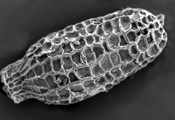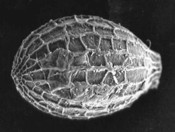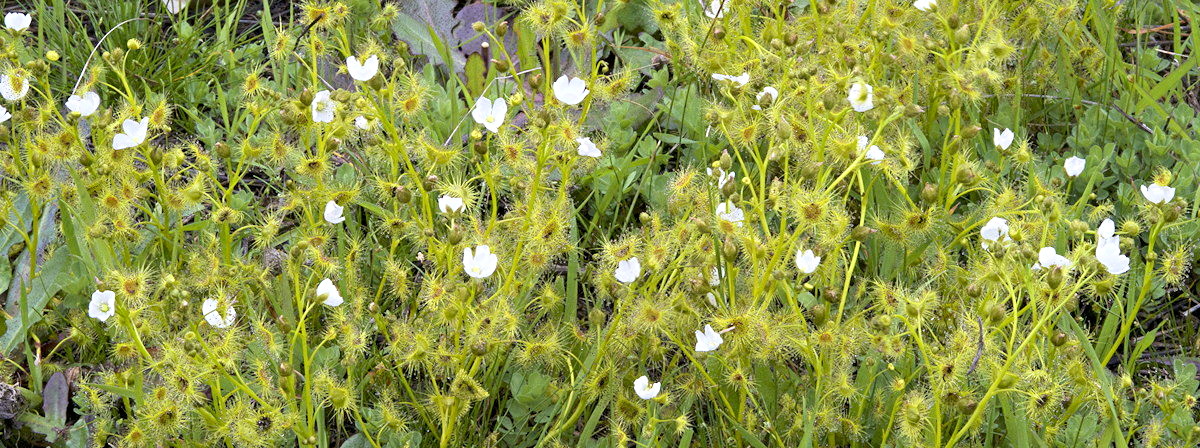
Drosera hookeri. Photo © Richard Nunn.
Contents
- History and discussion of the Drosera peltata species complex taxonomy.
- Distinctive characters of the species of the Drosera peltata complex.
- Drosera peltata complex seeds on 1 mm grid.
- Photos of plants in the Drosera peltata complex.
Species
|
Drosera peltata |
Drosera yilgarnensis |
History and discussion of the Drosera peltata species complex taxonomy.
There are a number of ways to typify the art of plant taxonomy. It could be considered a game that has been running for hundreds of years. Field botanists, who are intimately acquainted with live plants, create herbarium specimens consisting of dead, squashed, and dried representatives of plants they find in the wild. They may write descriptions of plants they think are new and give them a name or, as was more common in previous centuries, write a new name next to the specimen and let someone else do the description in Latin. Until recently the specimens were sent off to the great herbariums in Europe where guys sat around in their smoke filled offices, looked for distinguishing characters on the dead plants, compared new specimens to type specimens and decided what is a new species and what is not.
During the first 250 years of Linnean taxonomy, there was no globally accessible plant names database, online images of herbarium specimens, or a photofinder. The taxonomists in Europe were it. Now the specimens tend to stay in the country of origin, the field botanists have broad access to type specimens and databases, and they can write descriptions themselves in English. But that does not mean the game is over.
Should the field botanists leave the name game to experts? It could be argued that in fact, the field botanists have nothing to lose naming everything that they think is new. They could hit the jackpot the way Francis Buchanan-Hamilton did when a plant he proposed a name for in 1802 was officially described in Latin in 1824, affirmed in 1848, rejected in 1906, and (finally ?) accepted in 2012.
The taxonomic story of the Drosera peltata complex is long and quite convoluted. The major problem for taxonomists was deciding which characters to use to distinguish the species. As part of his PhD work, Robert Gibson helped solve the problem. The following is a short synopsis based on Gibson, Conn and Bruhl (2012, 2014) of why it took 215 years to get to somewhat of a resolution in 2014 with five species. As of 2018 the species complex has been divided into seven species based on additional fieldwork and herbarium specimen studies.
Drosera peltata was first described by Carl Peter Thunberg (1797) based on a plant collected near what is now Sydney, Australia. Subsequently about 12 names were applied to plants in the Drosera peltata complex, most of them not valid for technical reasons (see Schlauer, CP Names Database, for a list of synonyms).
Ludwig Diels (1906, Read online, pp. 110-113) decided, based on the herbarium specimens, the plants attributed to Drosera lunata, Drosera foliosa and Drosera gracilis were really Drosera peltata, leaving that species and Drosera auriculata as the only species he considered to be in the complex. Barry Conn (1981) went even farther and lamented that there was too much variation among the herbarium specimens and it was too hard to tell what was what so he proposed Drosera auriculata be relegated to a subspecies of Drosera peltata.
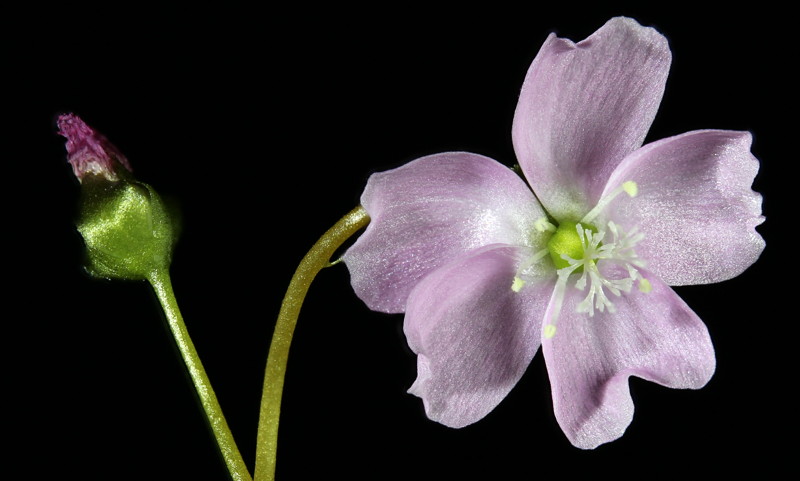
Flowers of Drosera auriculata, Howden, Tasmania, showing the glabrous sepals.
In the process of doing his review of Drosera peltata, Conn (1981) realized there was no appropriate type specimen for the Drosera peltata. After much sleuthing, he identified a plant (see photo on this page) that, if it is not the exact plant described, it is from the right location, collected at the right time, and most fits the written description. This plant turned out to be very similar to a plant from Arthurs Lake, Hampshire Hills, Tasmania, that was given the name Drosera gracilis by Joseph Dalton Hooker and described by Jules Émile Planchon (1848, Read online, type specimen at Kew K000215056). In this way the plants that we had recently been thinking of as Drosera peltata var. gracilis were shown to be the Drosera peltata described by Thunberg in 1797.
Here the story gets complicated. Gibson, Conn and Bruhl (2012) determined that the Drosera peltata complex consists of at least 5 species based on statistical cluster analysis of characters. The plant originally named Drosera gracilis along with Drosera peltata 'Red Rosette' needed to be separated from the rest of "Drosera peltata" as The Drosera peltata. Thus Drosera peltata became a narrowly described species with densely pubescent sepals and obovoid seeds.
Everything else attributed to Drosera peltata needed to go back to an old name or needed a new name. It was no surprise Drosera auriculata should go back to species status. They also found Drosera lunata should return to species status. A plant named Drosera peltata ‘Western Australian Form’ was different enough it needed a new name. That left one more taxon needing a name. A possible name was Drosera foliosa but that name was applied to Drosera intermedia in 1821, prior to its use for Drosera peltata in 1848.
Gibson, Conn and Conran (2010) coined Drosera hookeri as a replacement name for Drosera foliosa in honor of "Joseph Dalton Hooker (1817–1911) who originally recognized this taxon and provided a manuscript name which was used by J. É. Planchon (1848)". They selected Kew K000215054 (middle plant, top row) from Tasmania as the type specimen as it most closely matched the original concept of Drosera foliosa and most likely was part of the original type collection. Drosera hookeri as they defined it, usually has hairy sepals but some populations have glabrous sepals. The seeds are cylindrical compared to the more pointed seeds of Drosera peltata.
Drosera auriculata was originally described by Planchon (1848, Read online) based on specimens collected by Franz Sieber (Kew K000215087). Planchon used the name suggested by James Backhouse for plants he collected in 1836 near Sydney, Australia (Kew K000215045). Gibson, Conn and Bruhl (2012) selected the plant in the lower right of Kew K000215087 as the type specimen. This plant is generally known by its glabrous sepals and long, thin seeds.
The name Drosera lunata was proposed by Francis Buchanan-Hamilton for a plant that was nominally described by Augustin Pyramus de Candolle (1824, Read online) and more fully described by Planchon (1848, Read online). The type specimen from Nepal selected by Gibson, Conn and Bruhl (2012), BM000752951, is not online but there is a photo in their paper. This species has small ovoid seeds and usually has glabrous sepals.
The name Drosera yilgarnensis was coined for Drosera peltata ‘Western Australian Form’ by Gibson and Conn in Gibson, Conn and Bruhl (2012) with a type specimen chosen from a collection by Phill Mann in 2003 (see photo at right). The name comes from the granite outcrop called Yilgarn Craton where the plants grow. This species has glandular hairy sepals, the style divides into 30 and 60 segments and seeds are small and the most round of the complex.

Detail of drawing that was pinned on Gunn 784, the Drosera gracilis sheet type sheet from Arthurs Lake, Hampshire Hills, Tasmania. Original Image © Board of Trustees of the Royal Botanic Gardens, Kew.
Lowrie (2013) lists Drosera gracilis as a sixth species of the Drosera peltata complex. Basically, Lowrie contended the type specimen of Drosera peltata on the Sydney, Australia, Thunberg Herbarium 7720 sheet is not the same as the Drosera gracilis type specimen on the Arthurs Lake, Hampshire Hills, Tasmania, Gunn 784 sheet (K000215056). The specimens are close. But whether or not there are differences that can be readily seen on the type specimens themselves—even Lowrie (2013, pg. 480) admits it is difficult sorting collections of even recently dried specimens—the drawing pinned to the herbarium sheet helps make the differences clear (see photo above). Differences between Drosera peltata and Drosera gracilis are Drosera gracilis plants are less robust with smaller flowers (not valid taxonomic metrics), the upright growth is generally red instead of olive green (questionable taxonomic metric, both have red rosettes), and Drosera gracilis seeds have a hooked tip while Drosera peltata seeds do not (this is a valid taxonomic metric of key value to this species complex (Gibson, Conn and Bruhl (2012))).
Should the name be Drosera gracilis or Drosera peltata subsp. gracilis? Lowrie (2013) states that both Drosera gracilis and Drosera peltata can be found at sites growing together but the plants remain distinct. In particular, he mentioned he has been to a site in South Australia with four Drosera peltata complex species growing together. Actually, based on his description, the site had five species using the current taxonomy of the complex: Drosera peltata, Drosera auriculata, Drosera gracilis, Drosera hookeri, and Drosera gunniana. So, in effect, Lowrie (2013) reversed combining Drosera gracilis with Drosera peltata 'Red Rosette' making 6 species in the complex. This is the back-and-forth of taxonomy in action. The bottom line is Drosera gracilis has glandular hairy sepals and the seeds have a beak-like hook at the tip.

Flowers of Drosera hookeri, Dubbo, New South Wales, showing the marginal hairs on the sepals.
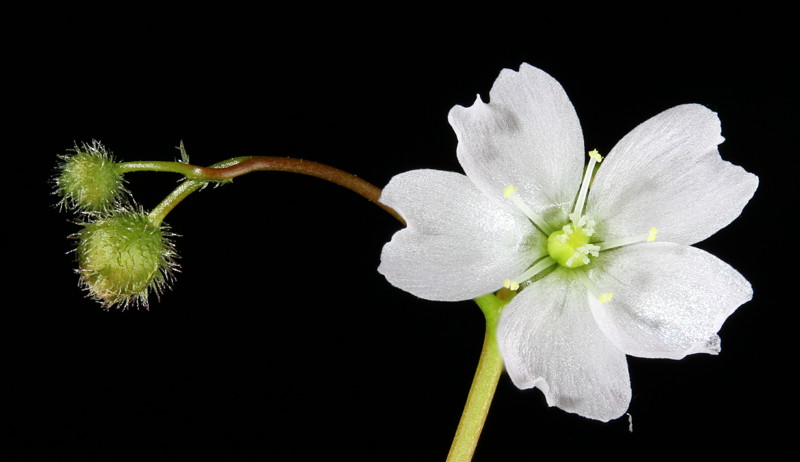
Flower of Drosera gunniana, orange plants, Conara, Tasmania, showing the densely hairy sepals.
In their morphometric analysis of the Drosera peltata complex, Gibson et al. (2012) identified Drosera hookeri as a widespread, quite variable species. However, de Salas (2018) reported that in Tasmania, there are two distinct plants that Gibson et al. identified both as Drosera hookeri, one green, one red/orange. In Tasmania, the typical Drosera hookeri is usually found in wetter areas than the plant de Salas named Drosera gunniana. Where they grow together, intermediate forms are found but extremely rare. The plants are easily distinguished by Drosera hookeri plants being yellowish green to yellow, flower buds longer than wide, sepals with sparse short hairs except long hairs on the margins, flower petals white, and tubers white. Drosera gunniana plants are green to red, often orange to red at the base, flower buds approximately spherical, sepals green or blackish with dense hairs, flower petals white or pink, tubers pink or red.
The taxonomic history of the Drosera peltata complex reflects the on-the-ground truth that the species complex is widespread enough and old enough with little genetic mixing between populations to present modern day taxonomists a challenge in deciding how to categorize the plants. In the 18th and 19th centuries, European taxonomists gave names to the various plants collectors brought back from expeditions to the far side of the planet. It can be hard to see many of the taxonomic details in old herbarium sheets, so in the 20th century, taxonomists threw up their hands and lumped the whole complex into Drosera peltata. Finally in the 21st century, with anyone able to see plants in the wild and grow them themselves, it became a "wait a minute" situation. Anyone who has seen Drosera auriculata in the wild or grown it realizes it really needed to be carved out of Drosera peltata as a separate species. Then it turned out the original Drosera peltata type specimen was another plant that should be carved out from the bulk of what had been called Drosera peltata. But while we are carving, Drosera lunata, Drosera yilgarnensis and Drosera gracilis needed to be carved out as well. This meant the new name, Drosera hookeri, became the name of the leftover plants from Drosera peltata and the catchall species name in the complex. Now that Drosera gunniana has been added to the mix making seven species names, it is unclear at this point whether Drosera hookeri is still the catchall species name or whether Drosera gunniana has claimed that role.
There are still distinct plants in the wild of the Drosera peltata complex that need some taxonomic recognition or reconciliation one way or another. The difficulty is taxonomy is done from herbarium specimens. This is so that 200 years from now, someone can go back to the exact specimen examined and determined to be the "type". The type specimen needs to display all of the characters used to decide on the separate name. Many old type specimens do not have all the necessary details. To the extent that one can go back to the exact location where the specimen was collected and find the population of plants sampled, new specimens can be collected and compared. A big problem, though, is many of the plants only have a period of a few weeks each year where they display the characters used to decide specific status. Or even worse, the characters may appear sequentially so there is no one sample with all of the important characters. And, the plants can appear differently each year based on weather conditions or differently in other locations owing to different environmental conditions. That is why there is a tendency to publish a new name with what evidence is available and leave it to future studies to confirm a name, or not. There is nothing wrong with throwing a name against the wall and seeing if it sticks. It forces the reckoning of a situation that otherwise can fester way too long. Rest assured, this page will need to be updated again.
— John Brittnacher
October 2014
Updated February 2021
For more information please see:
Thunberg, C. P. (1797) Dissertatio botanico de Drosera. In C. P. Thunberg (ed) Dissertatio Botanica. Edam, Uppsala.
Candolle, A.-P. de (1824) Droseraceae. In: A.-P. de Candolle (ed.) Prodromus systematis naturalis regni vegetabilis. Treuttel and Wurtz, Paris. (Read online)
Planchon, J.-É. (1848) Sur la famille des Droséracées. Revisio systematica Droseracearum. Annales des Sciences Naturelles, Botanique séries 3, 9:185–207,285-309. (Read online)
Diels, L. (1906) Droseraceae. In: A. Engler (ed.). Das Pflanzenreich: regni vegetabilis conspectus. Engelmann, Leipzig, Germany. pp. 1-137. (Read online)
Conn, B. J. (1981) The Drosera peltata-D. auriculata complex. Journal of the Adelaide Botanic Gardens 3:91-100.
Gibson, R., Conn, B. J., and Conran, J. G. (2010) Drosera hookeri R.P.Gibson, B.J.Conn & Conran, a replacement name for D. foliosa Hook.f. ex Planch. Nom illeg. (Droseraceae). Journal of the Adelaide Botanic Gardens 24:39-42.
Gibson, R., B. J. Conn, and J. J. Bruhl. (2012) Morphological evaluation of the Drosera peltata complex (Droseraceae). Australian Systematic Botany, 2012(25) 49–80. http://dx.doi.org/10.1071/SB11030
Lowrie, A. (2013) Carnivorous Plants of Australia Magnum Opus. 3 Volumes. Redfern Natural History Productions, Poole, GB.
Gibson, R. and B. Conn and J. Bruhl (2014) Resolution of the Drosera peltata complex (Droseraceae). Carniv. Pl. Newslett. 43(2):43-48. (PDF)
Salas, M. F. de (2018) Drosera gunniana comb. et stat. nov., a species in the Drosera peltata (Droseraceae) complex. Muelleria 36:97-106. (PDF)

The specimen on the right is the type of Drosera peltata. The specimen on the left is Drosera auriculata and was cut from a different sheet. Thunberg Herbarium 7720 at the Museum of Evolution Herbarium, Uppsala University, Sweden (UPS). Photo © Robert Gibson.
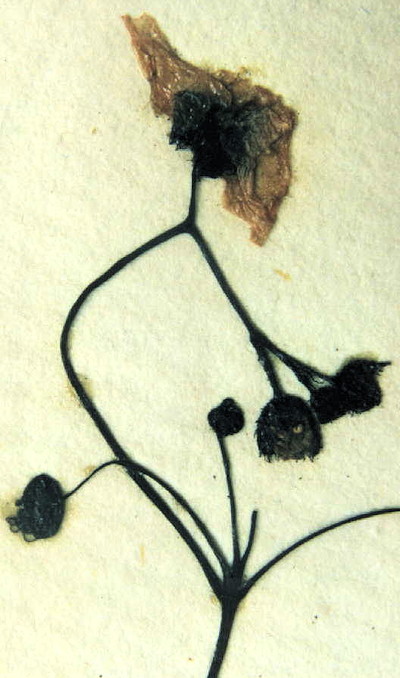
Close-up of the Drosera peltata type. Photo © Robert Gibson.
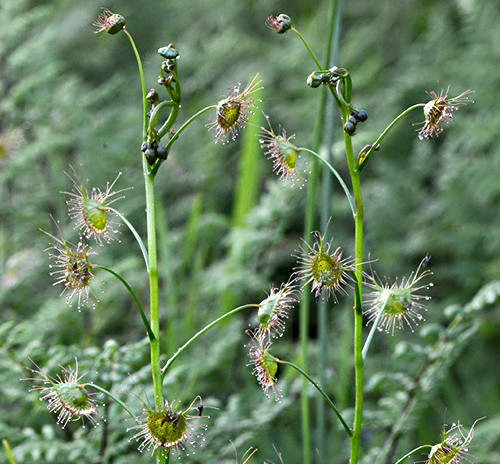
Drosera auriculata, Onkaparinga River National Park, South Australia. Photo © Richard Nunn.

Some of the specimens on the Drosera yilgarnensis type sheet. Phill Mann sheet 18/2003, Mt Madden, Roe region, Western Australia. Photo © Robert Gibson.
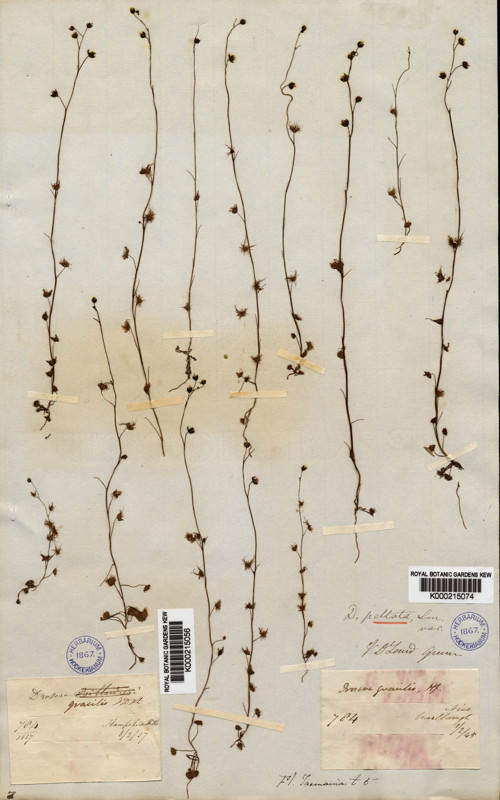
The Drosera gracilis, Gunn 784 sheet type sheet (K000215056) from Arthurs Lake, Hampshire Hills, Tasmania, after drawing was removed. Image © Board of Trustees of the Royal Botanic Gardens, Kew.
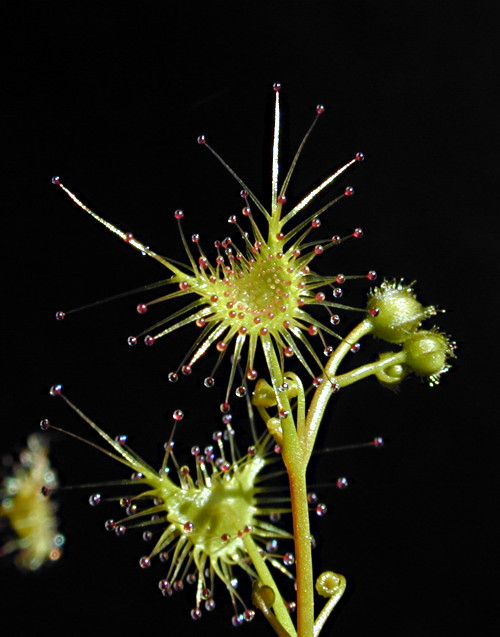
Drosera hookeri, Dubbo, New South Wales.

Drosera gunniana, Anstey Hill, South Australia. Photo © Richard Nunn.
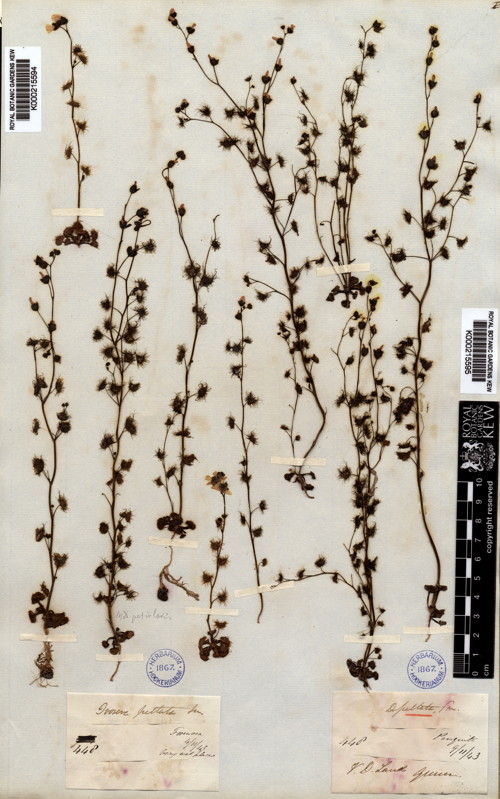
The type specimen for Drosera gunniana is the lower left plant on R.C.Gunn 448 (Kew K000215594). Image © Board of Trustees of the Royal Botanic Gardens, Kew.
Distinctive characters of the species of the Drosera peltata complex.
| Species* First Description |
Distribution | Habitat | Plant color | Tuber |
|
D. auriculata |
Southeastern Australia (Queensland, New South Wales, Australian Capital Territory, Victoria, South Australia), Tasmania, and New Zealand (North Island and South Island). |
Seasonally moist, rarely wet mineral soils, from sea level to elevations of at least 1300 m. |
Olive-green, rarely maroon (Tasmania) or red (New Zealand). |
Ovoid to globose, up to 10mm diameter by 8 mm tall; surface white to red. |
| D. peltata Thunberg (1797) |
Southeastern Australia (New South Wales, Australian Capital Territory, Victoria, South Australia), and Tasmania. |
Coastal and tableland wetlands, always in wet, often peaty soils, sea level to at least 1600 m elevation. |
Olive-green to greenish-bronze. |
Ovoid, up to 6 mm diameter by 5 mm tall; surface pink to red. |
| D. gracilis Planchon (1848) |
Southeastern Australia (New South Wales, Australian Capital Territory, Victoria, South Australia) and Tasmania. | Sea level to alpine elevations in wet, sandy or peaty soils. | Reddish. | Globose, 4 mm diameter; red. |
| D. hookeri Gibson, Conn and Conran (2010) |
Southeastern Australia (Victoria, South Australia) and Tasmania. |
Found in coastal, tableland and inland seasonally moist habitats in low to mid elevations. |
Bright yellow-green. | Ovoid, up to 5 mm diameter by 5 mm tall; surface white. |
| D. gunniana De Salas (2018) |
Southeastern Australia (New South Wales, Victoria, South Australia), Tasmania, and North Island, New Zealand. |
Found in woodland, grassy woodland and open, grassy habitats such as lawns in low to mid elevations. |
Green to red, often orange at base. | Ovoid, up to 5 mm diameter by 5 mm tall; surface pink to red. |
| D. yilgarnensis Gibson and Conn in Gibson, Conn and Bruhl (2012) |
Roe and Coolgardie regions of Western Australia, with most sites between Hyden, Coolgardie and Salmon Gums. |
Granite outcrops in the eastern Wheatbelt and the southern Goldfields, in thin gravelly soil that usually supports Borya sp. herbfields on lower slopes or on aprons of granite outcrops; usually where water accumulates. |
Red. |
Globose, up to 8 mm diameter, red. |
| D. lunata de Candolle (1824) |
Western margin of the Pacific Ocean Australia to Japan and east to India. Between Sydney, Australia, and central Honshu, Japan, and east to Shimla, Himcha Pradesh, in the Indian Himalayas. Diels indicated that this species occurs at least as far west as eastern Tajikistan. |
From sea level in subtropical locations, to elevations of at least 3600 m altitude in tropical mountains with one herbarium specimen possibly collected from around 6000 m altitude at Jagersar, Uttarakhand, in the Indian Himalayas. |
Usually olive-green. |
Ovoid, up to 9 mm diameter by 5 mm tall; surface white to red. |
| Species* | Flowering | Petals | Sepals | Styles | Seeds† |
| D. auriculata | July–February (Australia), September– November (New Zealand) |
white or pink |
Ovate, elliptic and rarely obovate, 2–6 mm long by 0.9–2.6 mm wide, glabrous with an entire to irregularly serrulate margin. |
3, 0.6–1.4 mm long, divided into a total of ~15–30 cylindrical segments. |
0.8–1.6 mm long, cylindrical with a shallowly reticulated surface |
| D. peltata |
April–February |
white or pink |
Ovate–elliptic, 1.5–6 mm long by 1.0–1.5 mm wide, densely pubescent (~5–30 hairs per mm2) with fimbriate margin of glandular hairs up to 0.4mm long . |
3, 0.25–1.0 mm long, divided into a total of between ~15 and 25 segments. |
0.4–0.8 mm long, ovoid to obovoid by up to 0.3 mm diameter, with a shallowly reticulated surface. |
| D. gracilis | August-January | white | Ovate, 2.5-3 mm long by 1.2-1.5 mm wide with stalked glandular hairs, margin fimbriate with glandular tips. | 3, 0.8-1.0 mm long divided in many segments. | 0.4-0.45 mm long, ovoid 0.2-0.25 mm diameter, beak-like tapering projection 0.1 mm long, offset to side. |
| D. hookeri | July-December | white |
Green, 2.5–3 mm long, 1.5–2.5 mm wide, appressed to the capsule after anthesis, margin ciliate, apex obtuse, often fimbriate; indumentum sparse, hairs 0.3–0.6 mm long, semi-appressed to appressed, longer on the margins and paler than sepal lamina. |
3, 0.3–1.2 mm long, divided into a total of between ~20 and 30 segments. |
0.6–0.7 mm long by up to 0.25 mm diameter, cylindrical with a deeply pitted surface. |
| D. gunniana | September-November | white or pink |
Green or blackish, 3–5 mm long and wide, only loosely clasping the capsule or spreading after anthesis, margins fimbriate, apex truncate; indumentum dense, hairs 0.8–1.2 mm long. |
3, 0.3–1.2 mm long, divided into a total of between ~20 and 30 segments. |
0.5 mm long by up to 0.25 mm diameter, ovoid to almost cylindrical with a deeply pitted surface. |
| D. yilgarnensis | July–November | white |
Narrowly ovate to elliptic, typically 2–4 mm long by 0.6–1.2 mm wide, margin and apex fimbriate with glandular hairs up to 0.3mm long, adaxial surface moderately hairy (20–40 hairs per mm2) with stalked glandular hairs. |
Multiply divided from base into many (usually 30–60) terete segments, up to 1 mm long, white with an orange base. |
~0.3–0.5 mm long by up to 0.3 mm diameter, base rounded and apex often apiculate, surface with ~12 longitudinal rows of ovoid pits. |
| D. lunata |
Throughout year. March- |
white or rarely pink |
Ovate, elliptic, rhombic or ovate, 1.4–4.2 mm long by 0.6–1.8 mm wide, glabrous with the margin entire to serrulate, or denticulate, to partially to fully fimbriate with hairs up to 0.6 mm long. | 3, 0.4–1mm long, divided into a total of ~15–30 cylindrical segments. |
0.3–0.6mm long by 0.3 mm maximum diameter, ovoid with a shallowly reticulated surface. |
*Data from Robert Gibson, Barry J. Conn, and Jeremy J. Bruhl. (2012), Lowrie (2013) and de Salas(2018).
†Seed images courtesy of Robert Gibson.
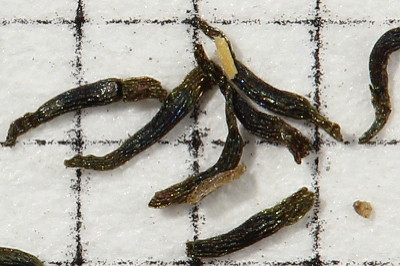
Drosera auriculata, Bathurst, New South Wales, Australia.
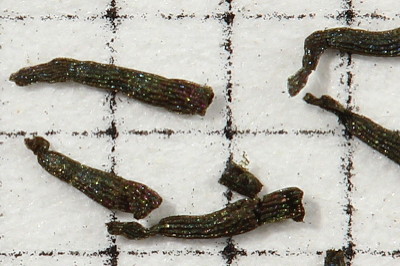
Drosera auriculata, Mt. William, Victoria, Australia.
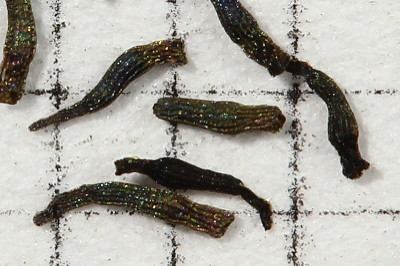
Drosera auriculata, Clare Valley, South Australia.

Drosera auriculata, Howden, Tasmania.
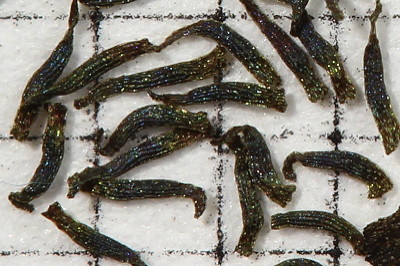
Drosera auriculata, Cooks Beach, Coromandel, New Zealand.
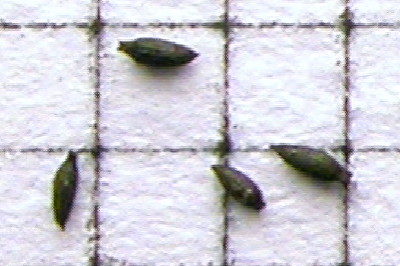
Drosera peltata.
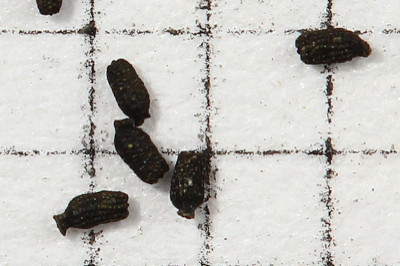
Drosera hookeri, Greenvale, Victoria, Australia.

Drosera gunniana, orange plants, Conara, Tasmania.
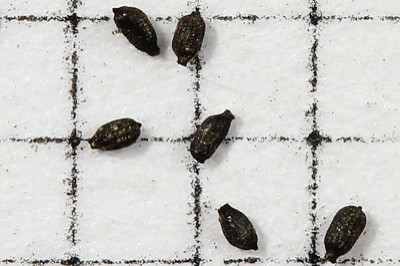
Drosera gunniana, Brighton, Tasmania.
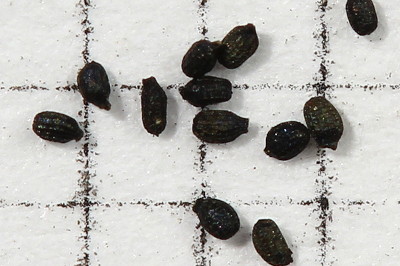
Drosera gunniana, Northlands, New Zealand.
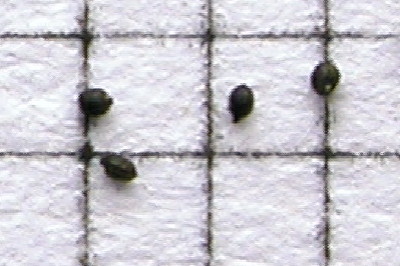
Drosera yilgarnensis, Western Australia.
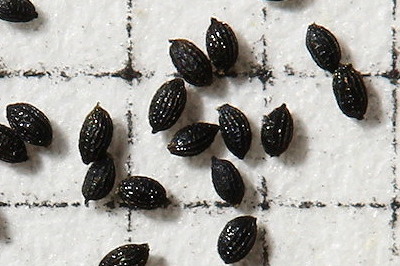
Drosera lunata, Doi Suthep, Thailand
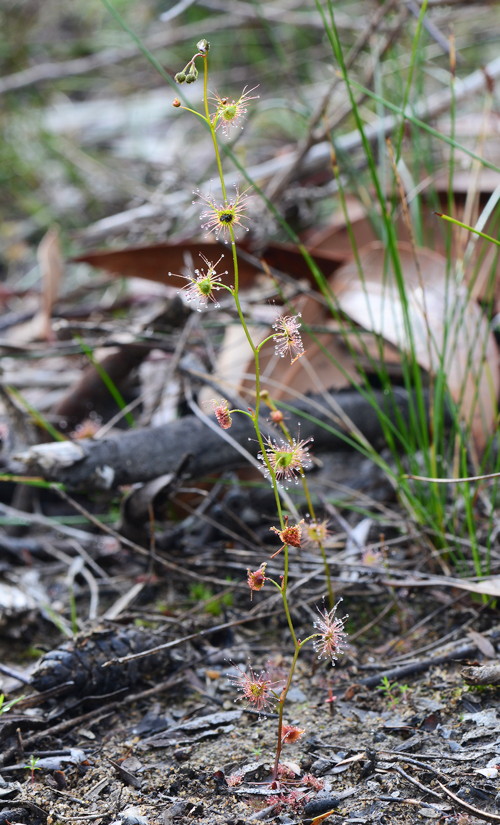
Drosera peltata, Georges River National Park, New South Wales. Photo © Richard Nunn.
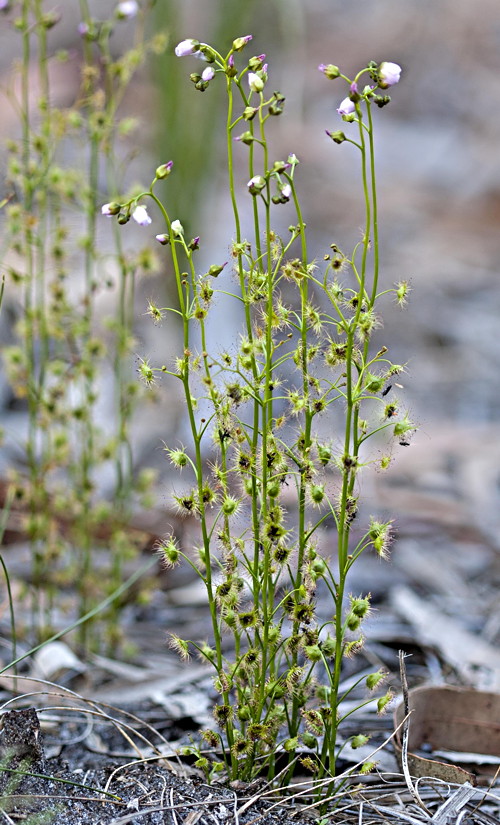
Drosera auriculata. Photo © Greg Bourke.
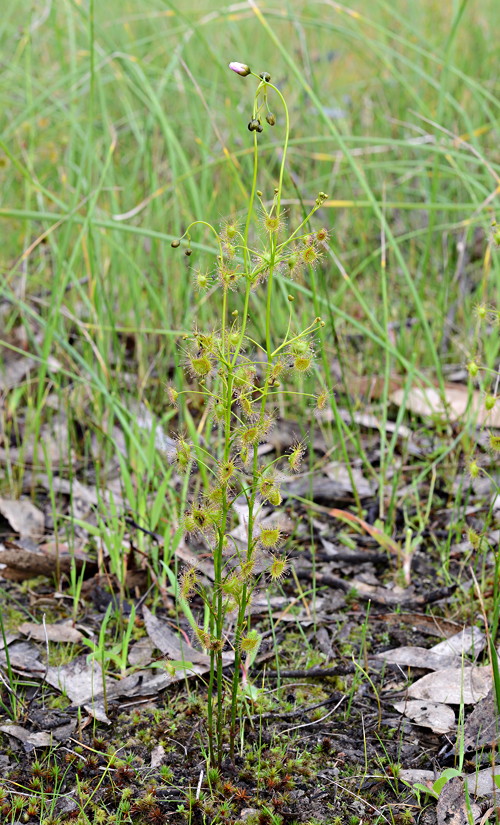
Drosera auriculata, Onkaparinga River National Park, South Australia. Photo © Richard Nunn.

Drosera auriculata Anstey Hill, South Australia. Photo © Richard Nunn.
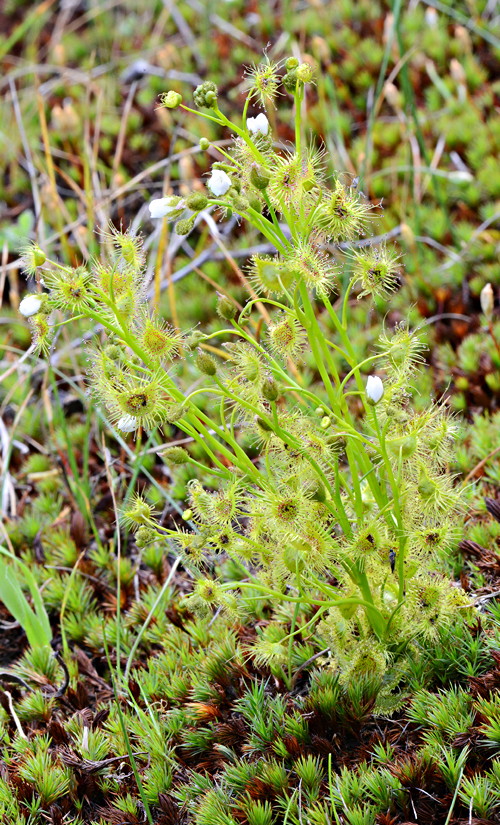
Drosera hookeri, Stipiturus Nature Reserve, South Australia. Photo © Richard Nunn.
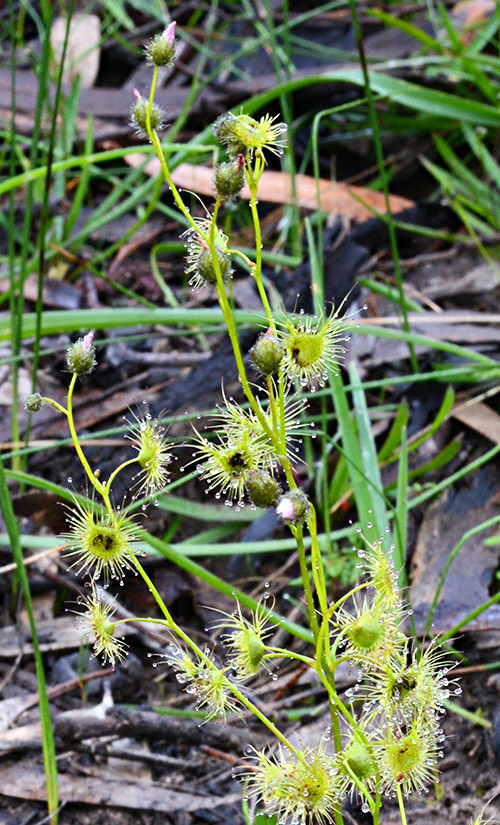
Drosera gunniana, Anstey Hill, South Australia. Photo © Richard Nunn.
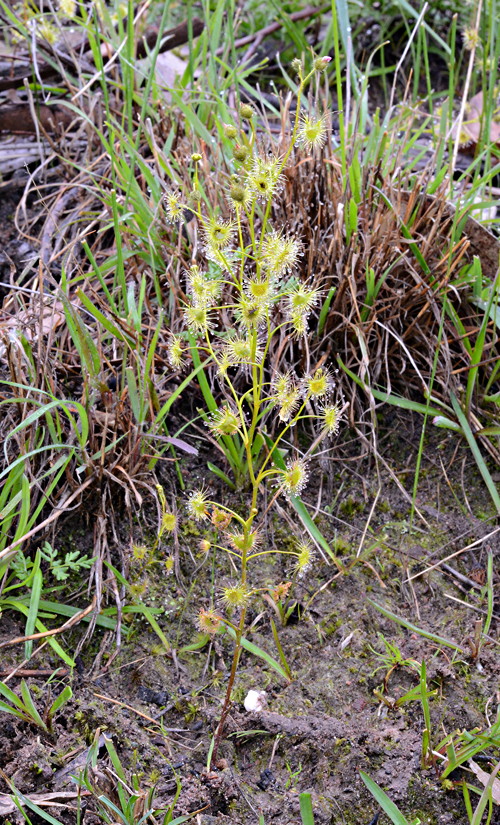
Drosera gunniana, Anstey Hill, South Australia. Photo © Richard Nunn.
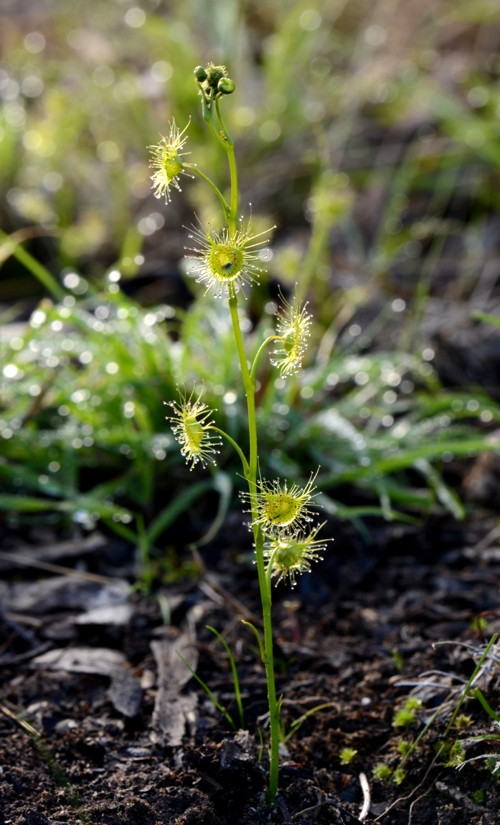
Drosera gunniana, Anstey Hill, South Australia. Photo © Richard Nunn.
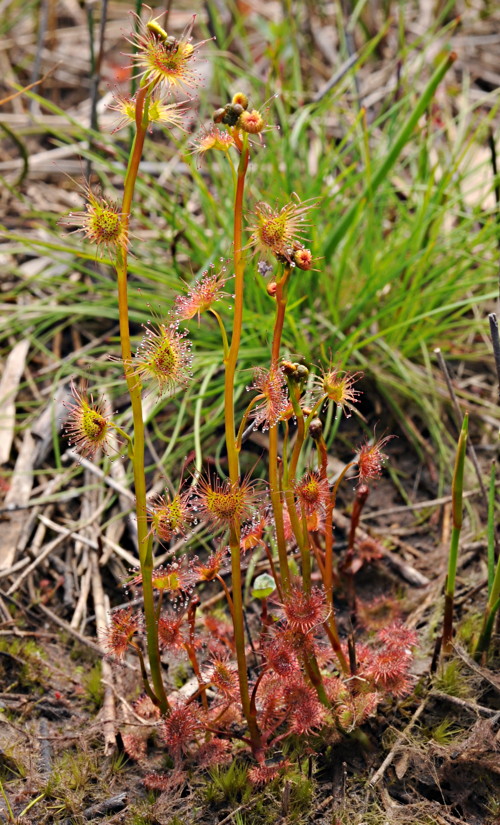
Drosera gunniana, Langwarren, Victoria. Photo © Richard Nunn.

Drosera gracilis, Cradle Mountain, Tasmania. Photo © Richard Nunn.
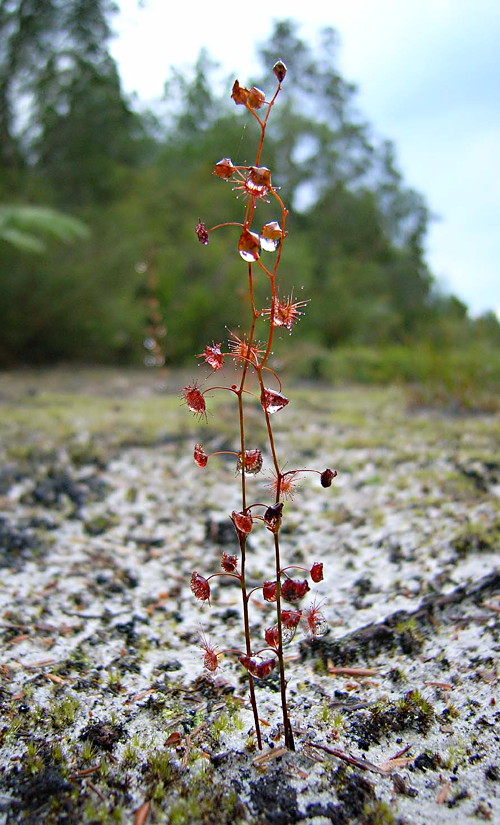
Drosera lunata. Photo © Greg Bourke.
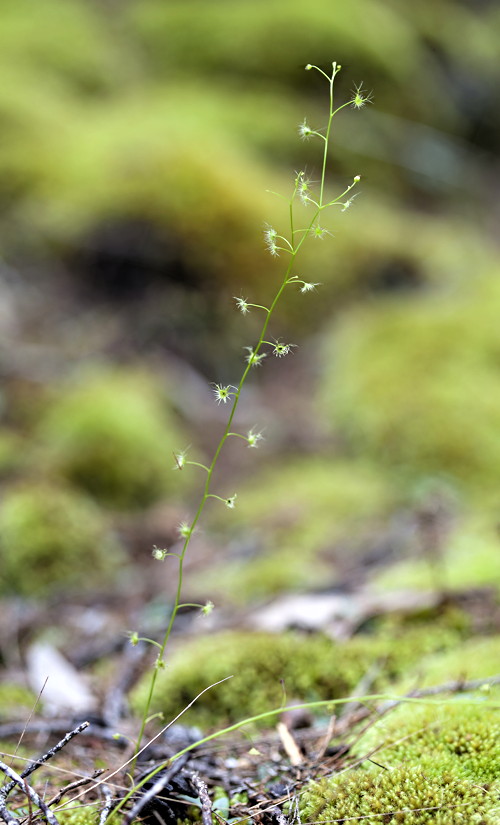
Drosera lunata. Photo © Greg Bourke.
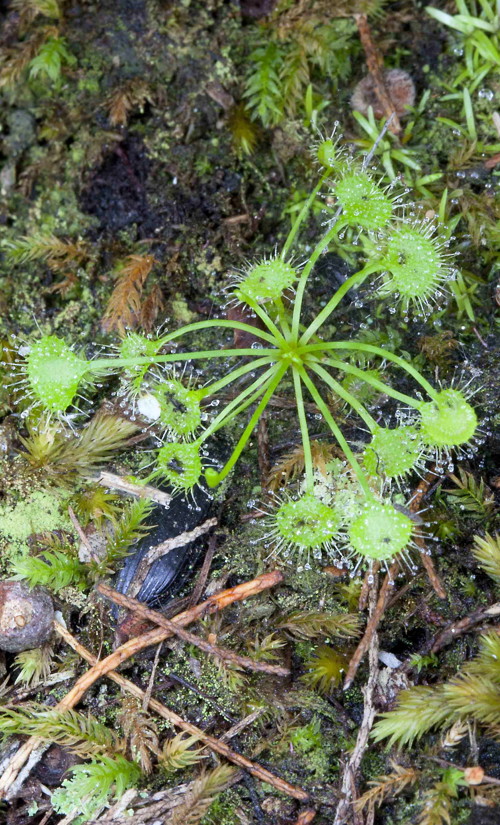
Drosera lunata. Photo © Greg Bourke.
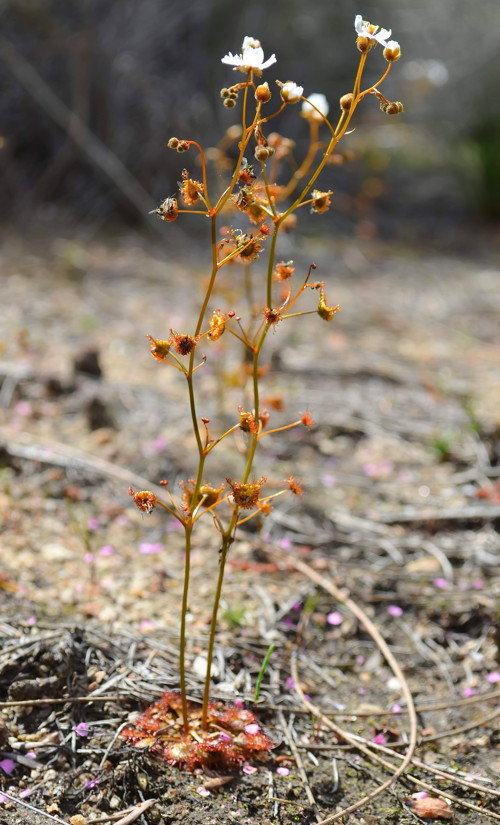
Drosera yilgarnensis, West Australia. Photo © Thilo Kruger.

Drosera auriculata, Anstey Hill, South Australia. Photo © Richard Nunn.
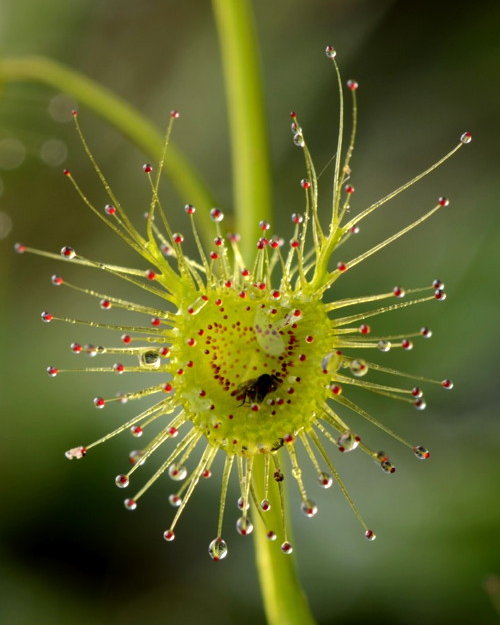
Drosera gunniana, Anstey Hill, South Australia. Photo © Richard Nunn.
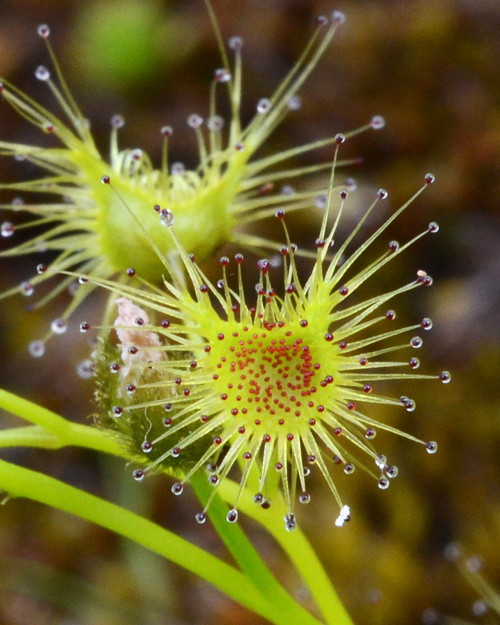
Drosera hookeri, Stipiturus Nature Reserve, South Australia. Photo © Richard Nunn.
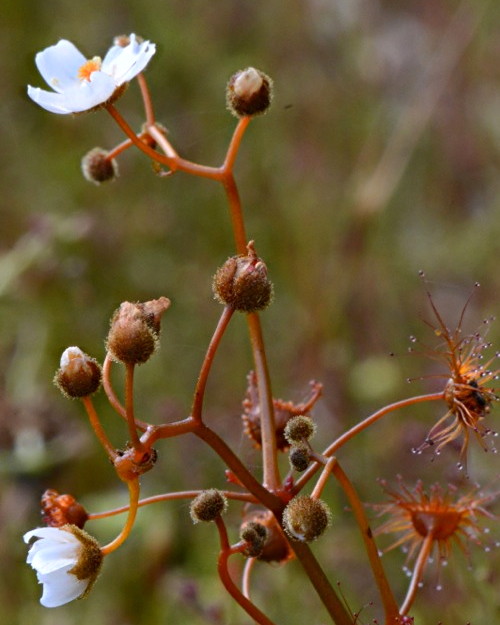
Drosera yilgarnensis , West Australia. Photo © Richard Nunn.
Close-up photos of flowers.
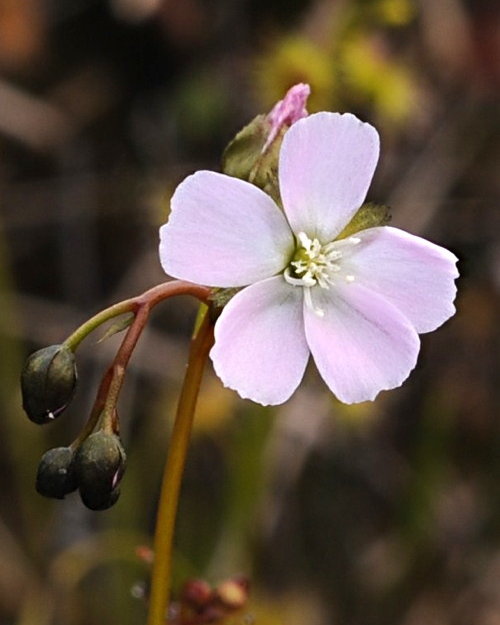
Drosera auriculata, Victoria, Australia. Notice glabrous sepals. Photo © Richard Nunn.
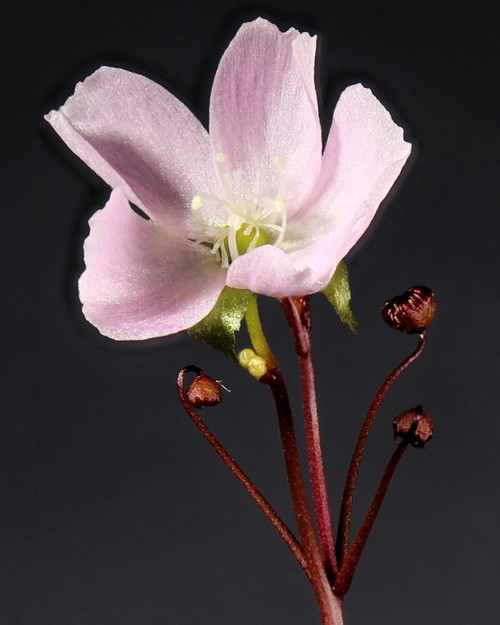
Drosera auriculata, Mt. Buffalo, Victoria. Photo © John Brittnacher.

Drosera gunniana, South Australia, Victoria border. Photo © Richard Nunn.
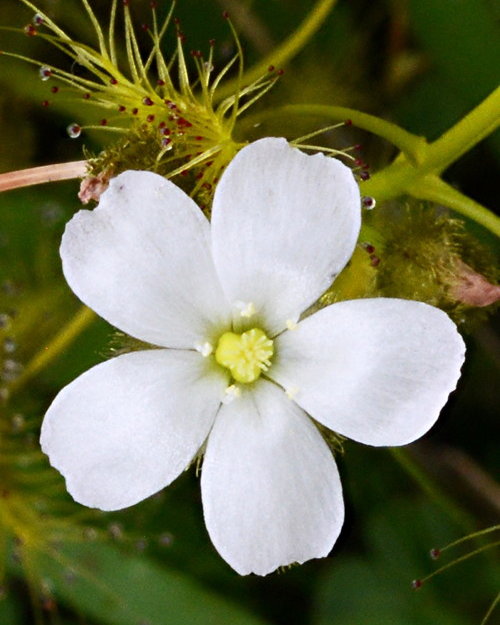
Drosera hookeri, Stipiturus Nature Reserve, South Australia. Photo © Richard Nunn.
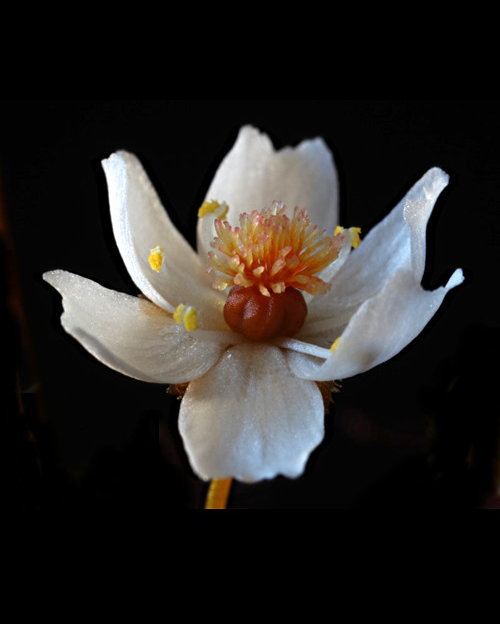
Drosera yilgarnensis. Photo © Robert Gibson.

Drosera yilgarnensis. Photo © Richard Nunn.
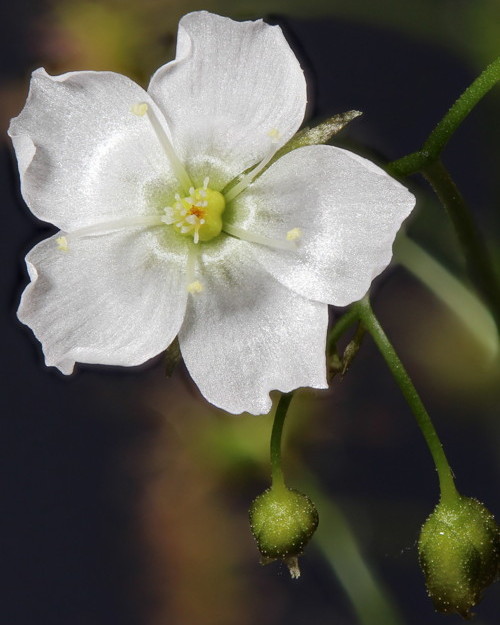
Drosera lunata, Doi Suthep, Thailand. Photo © John Brittnacher.

Drosera lunata, Queensland, Australia. Photo © Greg Bourke.


